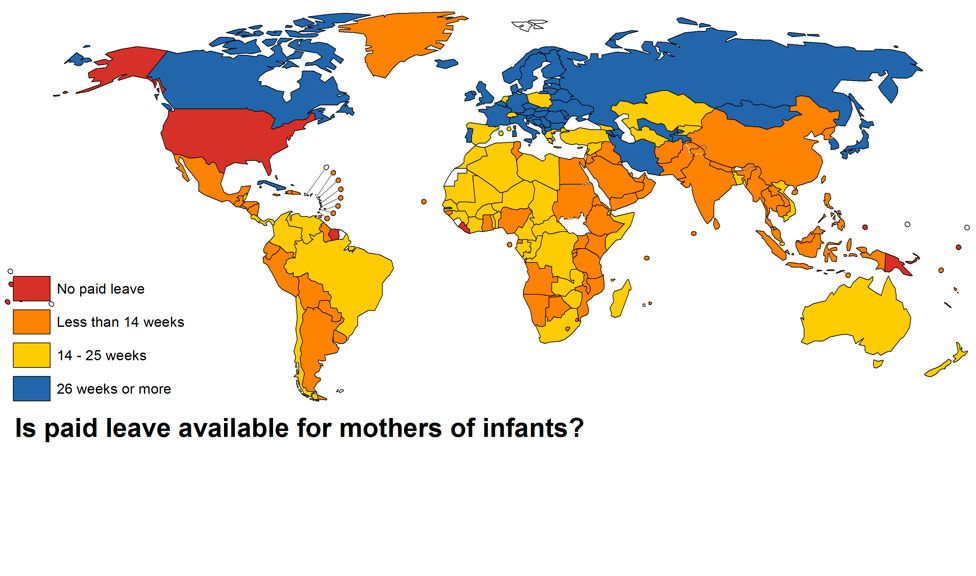Mapping children's chances
- Published

The biggest ever global picture of children’s well-being, education and family life has been assembled into a series of maps by the University of California, Los Angeles. "When you look at a map, everyone's eyes go straight to where they live," says Dr Jody Heymann, director of the university's World Policy Analysis Centre. In the US, they might be surprised to see how unusual it is not to have a statutory right to maternity pay. Source: The maps are produced by UCLA's World Policy Analysis Centre, Adult Labour Database www.childrenschances.org
There is plenty of information published about childhood and families, says Dr Heymann. "But with immense respect, much of it's unusable, no one is going to read the reports." But putting information into maps gives citizens the type of instant overview usually only available to academics or governments, she says. "It shows what can be achieved." Here is a small selection of dozens of maps produce by the UCLA team. Source: World Policy Analysis Centre, Adult Labour Database www.childrenschances.org
The maps can challenge what is considered to be usual or acceptable, by showing what happens in other countries, say the researchers. This map shows how few countries ensure the legal right of an education for children with disabilities Source: World Policy Analysis Centre, Constitutions Database www.childrenschances.org
There are also cases where there are rights for mothers in developing countries which are not available elsewhere. The maps draw upon data on public policies from 193 UN member states Source: World Policy Analysis Centre, Adult Labour Database www.childrenschances.org
"The impact of maps means that you can see clusters that you wouldn't see before. It shows the patterns," says Dr Heymann. Wealthier countries expect and can provide higher levels of education for primary teachers. Source: World Policy Analysis Centre, Education Database www.childrenschances.org
Education is also interlinked with other social factors such as the local labour market. "If children are able to work, marry young, then it's going to have an impact on their education," says Dr Heymann. The map shows the choices made by neighbouring countries, she says, such as the tighter child labour laws in Chile. Source: World Policy Analysis Centre, Child Labour Database www.childrenschances.org
This chart shows that there are legal limits over children's access to alcohol in many countries, with cultural as well as economic differences. Source: World Health Organisation, World Health Observatory Data Repository www.childrenschances.org
The global maps reveal how much attitudes to health can differ. In many countries there are no smoking bans for schools. Source: World Health Organisation, World Health Observatory Data Repository www.childrenschances.org
What is safety in childhood? In many countries there are no legal obligations to wear seat belts in a car. Source: World Health Organisation, World Health Observatory Data Repository www.childrenschances.org
The world is starkly divided in the provision of health care. Western countries and most of south America have access to dentists unavailable to families in most other countries. Source: World Health Organisation, World Health Observatory Data Repository www.childrenschances.org
There are very few countries where there are specific laws against racial discrimination at work Source: World Policy Analysis Centre, Constitutions Database www.childrenschances.org
Social conditions and the economics of family life are all part of the story of children's well-being and their ability to progress. There is much less assistance available in many fragile African economies Data source: World Policy Analysis Centre, Poverty Database www.childrenschances.org
The chances of a child getting a safe drink of water vary widely according to where a child is born. In many places the odds are stacked against them. Data source: World Policy Analysis Centre, Poverty Database www.childrenschances.org
Around the BBC
Related Internet Links
The BBC is not responsible for the content of external sites.